- 26 Kentucky Facts: Fun Facts About Kentucky You Need To Know - November 3, 2023
- 26 Florida Facts: Fun Facts About Florida You Need to Know - October 20, 2023
- 26 North Carolina Facts: Fun Facts About North Carolina To Know - October 13, 2023
Looking for the historical sites and national parks in Arkansas? Here’s a complete list of all sites operated by the US National Park Service.
Arkansas is not well known for its national parks, but you will find many of their parks are gorgeous and rich in history.
Boasting lots of natural beauty and history, Arkansas national parks are a treat for outdoor lovers and history buffs.
Here you can explore American history, learn about Arkansas’s involvement in the Civil War, travel along the Trail of Tears, or paddle down the Buffalo River.
8 Arkansas Parks and Historic Sites
1. Arkansas Post National Memorial
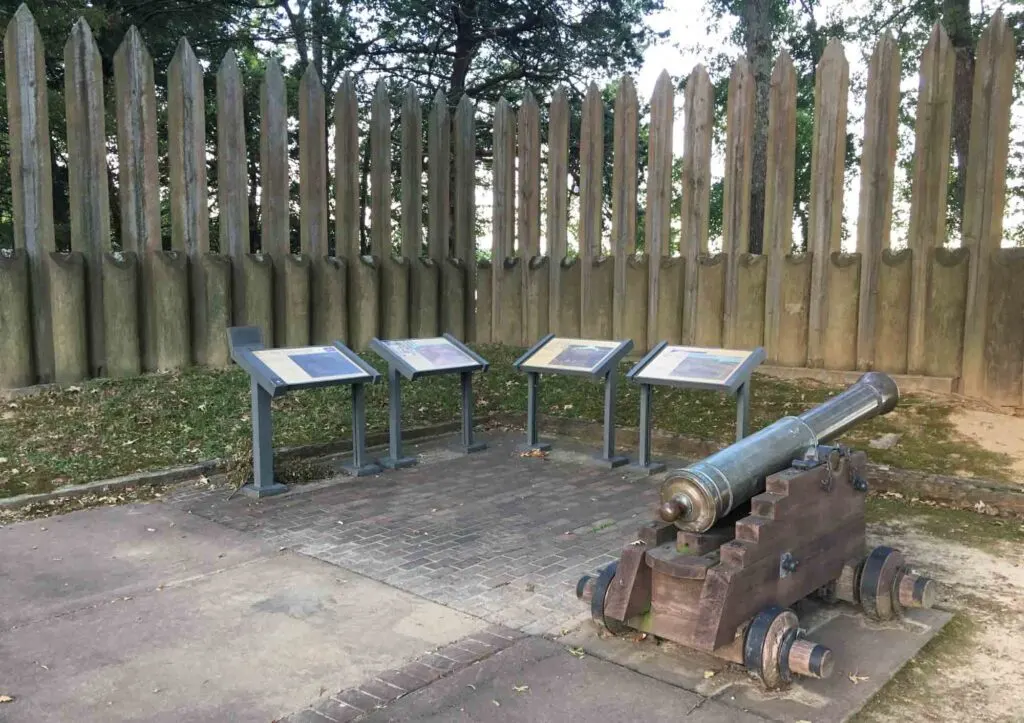
If you’re looking for a park rich in history, head to the national memorial in Arkansas, the Arkansas Post.
Just under a 2-hour drive from Little Rock, visit the memorial’s natural charm surrounding the memorial.
Be sure to explore the Visitor Center and museum to learn about the 300 years of human history at the Arkansas Port.
The visitor center offers historic armament demonstrations and guided historical tours that require registration.
Good to know: The musket and cannon demonstration is on a set schedule during peak hours.
This Arkansas park is the first European settlement in the lower Mississippi River Valley.
After the Louisiana Purchase in 1803, the Arkansas Post became a part of the United States. This post was the largest city in the region and was selected as the first capital of the Arkansas territory.
There are plenty of activities to choose from when visiting this national park in Arkansas.
Located on the peninsula bordered by the Arkansas River and two backwaters, this park offers terrific opportunities to view wildlife, hike one of the many trails, or take a fishing trip.
Visit the park: Visit the National Park Service’s website for practical info and directions to the Arkansas Post National Memorial.
Read next: 13 Best East Coast National Parks Ranked
2. Buffalo National River
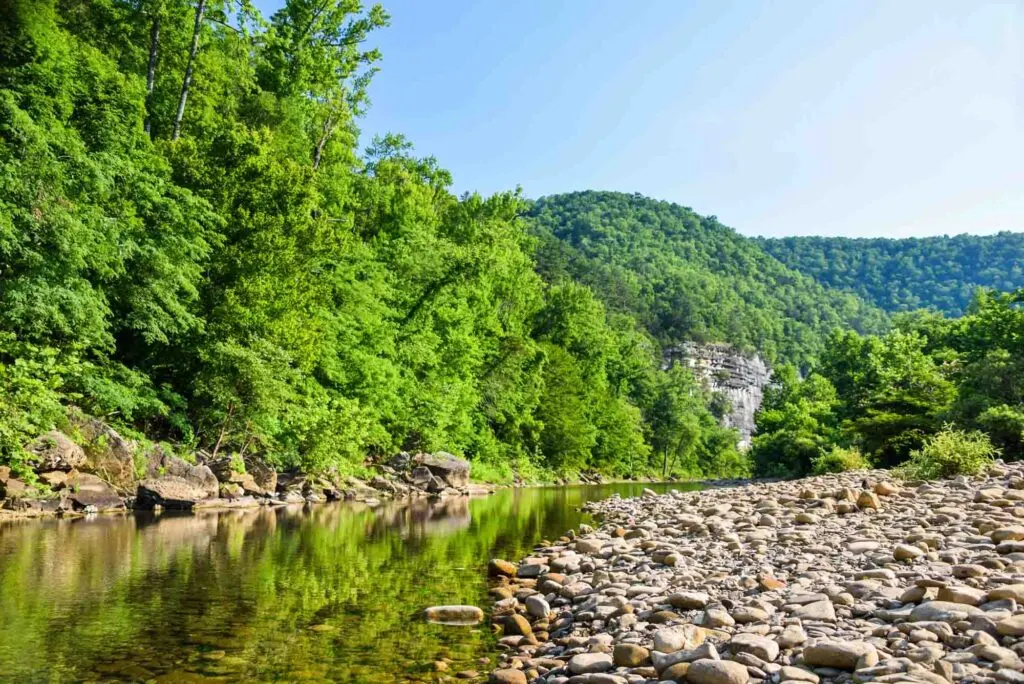
The first national river, established in 1872, is one of many national parks in Arkansas you won’t soon forget. This river flows through some of the most beautiful limestone bluffs in America.
One of the few undammed rivers remaining in the United States, explore the wide variety of natural wonder and abundance of outdoor activities.
Paddle along the 135 miles of national river and hike the 95,000 acres surrounding the lush river. There are hundreds of trails and many places you can embark on a kayak adventure.
Plan a stay in one of the many campsites featured around the park. Choose from several campsite locations and be sure to check the fees on the website to be prepared.
The Buffalo National River has no shortage of historical locations. People have inhabited the Ozarks for 1,000s of years, although European settled in the 1800s.
The park protects and preserves the many historic landscapes that people once called home.
Visit the park: Visit the National Park Service’s website for practical info and directions to the Buffalo National River.
Read next: All US National Parks + Printable Checklist
3. Fort Smith National Historic Site
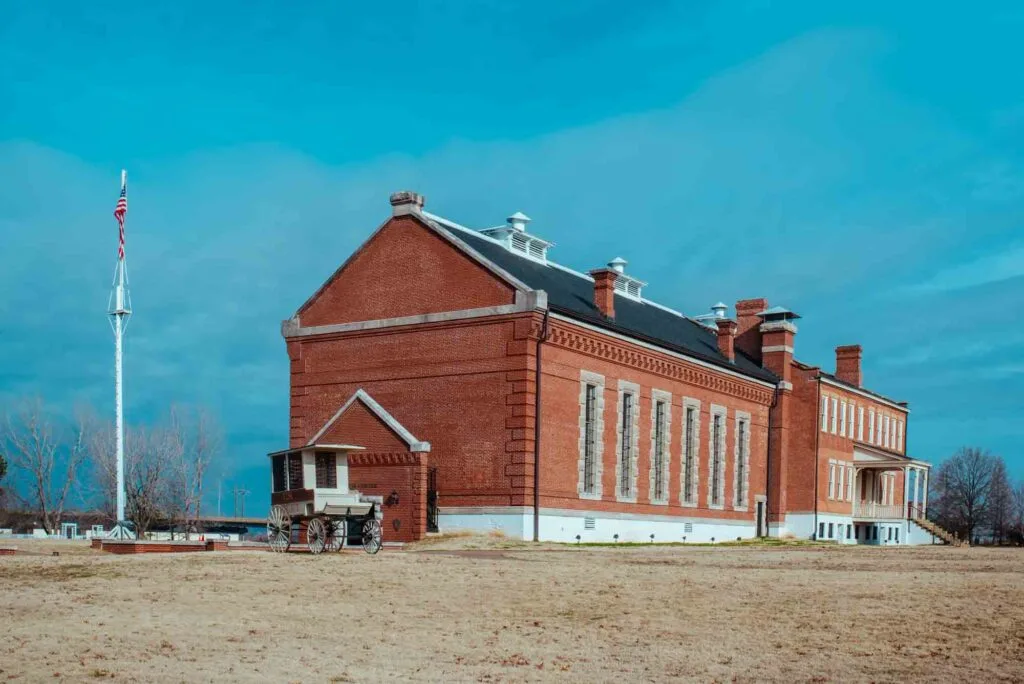
Calling all history buffs to Fort Smith National Park! Visit this Arkansas national historic site where the wild west once reigned.
Take a walk along the Arkansas River and learn about the Trail of Tears crossed. Visit the overlook lined with information panels that tell the story of the five tribes forcibly removed to Indian Territory.
In 1861, Confederate soldiers used the city as recruiting and training grounds for Confederate forces. In 1863, Union forces reclaimed Fort Smith after many bloody civil war battles.
The Visitor Center at Fort Smith National Historic Site is located near the south end of the barracks/jail/courthouse building.
The visitor center focuses on Fort Smith’s military history from 1817 – 1871, the western expansion, and the federal court’s impact on the Indian Territory, Federal Indian policy, and Indian Removal.
Surprisingly, many wild west outlaws met their doom at the fort smith gallows, where a replica now stands. Take a trip back in time and visit the oldest building, the commissary, which looks as it did in the 1850s.
Take a stroll around the River Loop Trail, which is open year-round. The trail is paved and an easy walk to explore the ground’s rich history.
Visit the park: Visit the National Park Service’s website for practical info and directions to the Fort Smith National Historic Site.
4. Hot Springs National Park
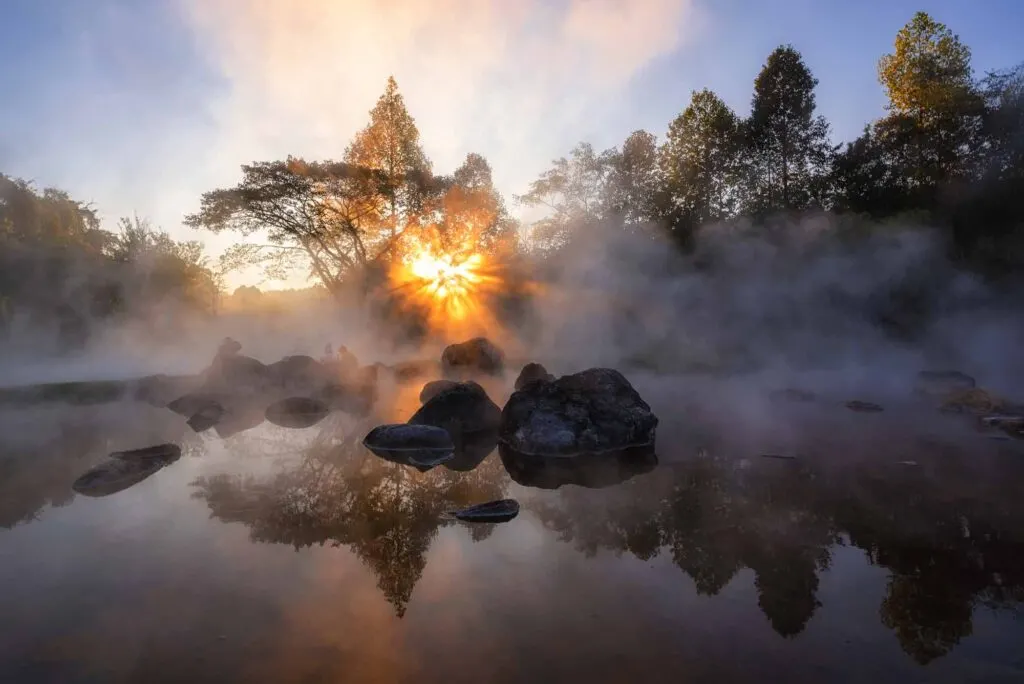
This Arkansas national park could be the sole reason you visit Arkansas, and you would leave happy.
Ancient thermal springs, mountain views, 26 miles of hiking trails, and abundant creeks, what more could you ask for?
Travel down to Hot Springs National Park to find two places to touch the thermal water, The Display Spring and the Hot Water Cascade.
The Hot Springs National Park once featured a bathhouse row, considered America’s spa.
As popularity grew, they began to construct sturdy bathhouses made of masonry and steel that are still standing today.
Designated as a national historic landmark district, Hot Springs National Park is a must-visit in Arkansas!
Spend a day exploring and learning about each of the historic bathhouses and the history that comes with it.
There are still two available facilities that offer people the chance to submerge and relax in the natural thermal water.
When visiting Hot Springs, be sure to visit the mountain tower and take in all the sights it has to offer.
The open-air upper deck offers a breathtaking view from 1,256 feet above sea level and takes in the history from the lower observation deck. The tower operates daily from 9 am to 5 pm, and general admission is $10.
While you’re there, stay at the Gulpha Gorge Campground, which can accommodate both tents and RVs. The cost to stay is a flat rate of $30 per day.
Visit the park: Visit the National Park Service’s website for practical info and directions to the Hot Springs National Park.
5. Little Rock Central High School National Historic Site

Plan your visit to the cultural and historic Little Rock Central High School.
Central to the civil rights movement, the visitor center features many exhibits where you can learn about the desegregation of the Little Rock Central High School.
Take a trip to this Arkansas park and learn about the massive resistance in the South that provoked opposition in Little Rock to integration during the 1957 crisis.
Learn more about the brave Little Rock Nine, the first black students to attend an all-white school, and their challenges during the turbulent time.
This national park in Arkansas is a fully operational public high school. Visitors without a guide a limited to the reflection pool and standing on the steps of the Central High School.
Still, to enter the high school, visitors need to be escorted by a park ranger. It’s free to visit and if you would like a guided tour, be sure to book in advance as they are required.
Visit the park: Visit the National Park Service’s website for practical info and directions to the Little Rock Central High School.
6. Pea Ridge National Military Park
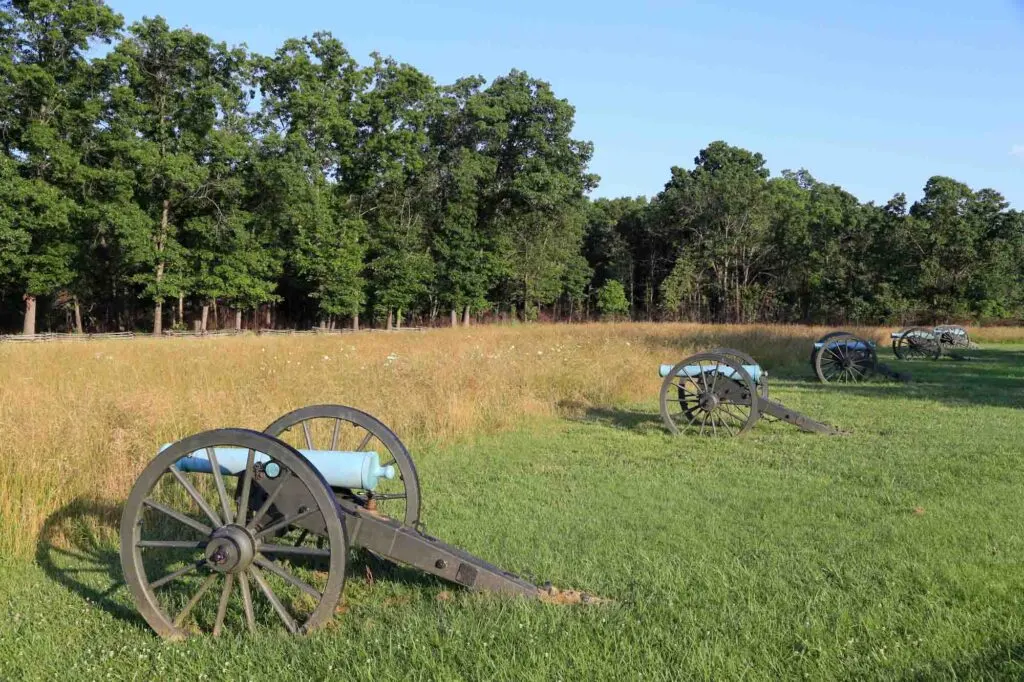
Many national parks in Arkansas are abundant in history from the Civil War, and Pea Ridge National Military Park is no different.
Just north of the Ozark National Forest in northwest Arkansas, you’ll find Pea Ridge, a park that was was a pivotal battleground that saved Missouri for the Union.
If you enjoy history, take a stroll along one of the most intact battlefields in the United States and perfect to brush up your history on the civil war.
Whether you like to explore and learn on your own or participate in a guided tour, you’ll learn about the 4,300 acres where north met south with over 23,000 soldiers.
Take a walk around this Arkansas military park and get an idea of just how significant the park is.
This walk is a little over two miles and takes you through many historical sites like Williams Hollow Field Hospital Site and Clemens Field. Enjoy scenic lowlands and highlands.
Come for the history where you can learn about the thousands of volunteer soldiers and read their many diary entries telling of the battle.
This Arkansas park also provides you with many online resources to take a digital tour of the lush fields and learn about the events that happened there.
Visit the park: Visit the National Park Service’s website for practical info and directions to the Pea Ridge National Military Park.
7. President William Jefferson Clinton Birthplace Home

Head on over to Hope, Arkansas, the birthplace of the 42nd president of the united states, President William Jefferson Clinton.
Take a guided history tour with park rangers and learn about a range of programs at the site, including Hopalong Cassidy, Family Tree, and a Photo Tour. Feel free to ask one of the rangers at the site about our programs.
Enjoy the gorgeous rose garden dedicated to Bill Clinton’s mother.
When taking a trip to visit the home, be sure to check out the small charming sites and visit Old Washington State Park, a 101-acre Arkansas state park in Hempstead County, Arkansas.
The museum in the village contains a collection of pioneer artifacts from Washington, Arkansas, a former pioneer settlement along the Southwest Trail.
Visit the park: Visit the National Park Service’s website for practical info and directions to the President William Jefferson Clinton Birthplace.
8. Trail of Tears National Historic Trail
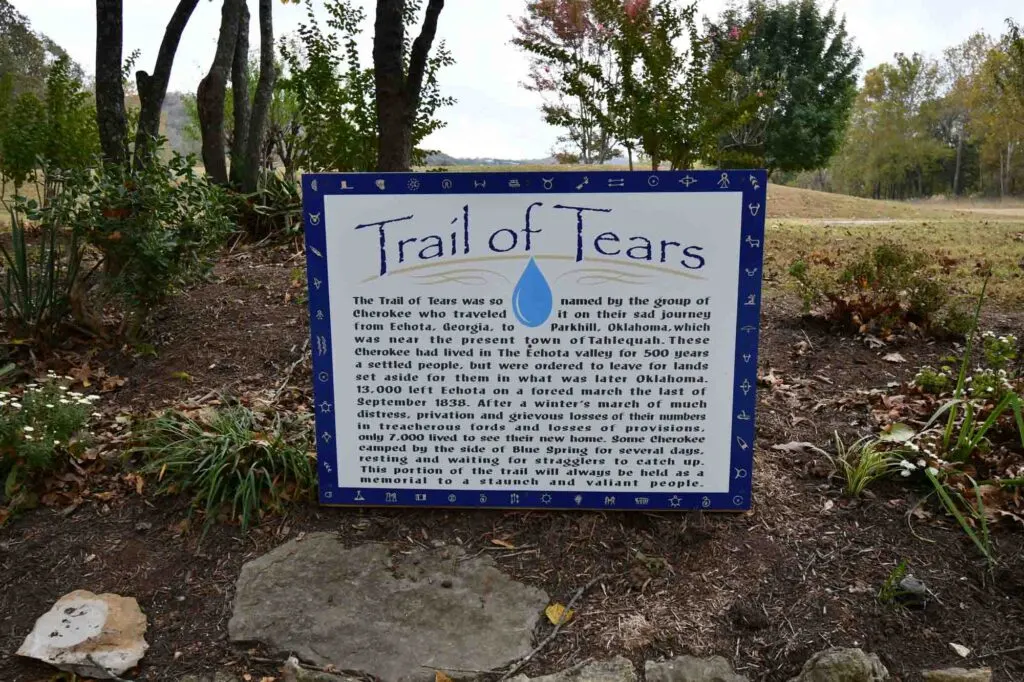
The Trail of Tears is a site of injustice. In 1830, congress passed the Indian Removal Act, which meant Indian Tribes of the Cherokee, the Choctaws, Muscogee Creeks, Seminoles, and Chickasaws, in all southeastern states along the Mississippi River, had to give up their land in exchange to relocate to Indian Territory (Oklahoma now).
Many Indians fought this movement but most agreed to move on. More than 16,000 Cherokee Indians were uprooted from their homelands in Tennessee, Alabama, North Carolina, and Georgia.
The forced migration executed more than 1,000 Cherokee and deserted hundreds along the way, which was only completed in 1839.
Needless to say, the Cherokee struggled in their new, unfamiliar territory but are now a proud independent tribe.
Hike along with many places in this Arkansas park. Or take a road trip, bike, or ride a horse to many sacred sites that tell of the Cherokee’s suffering, intolerance, and survival.
The trail covers 5,043 miles across nine states, and there are many places of interest to visit while exploring the trail of tears.
This Arkansas national parks site offers a trip itinerary to help you navigate the trail of tears with ease.
Visit the park: Visit the National Park Service’s website for practical info and directions to the National Historic Trail of Tears.
Map of All National Parks in Arkansas
Here’s a free and interactive map of all historical sites and national parks in Arkansas.
Did you enjoy reading about the national parks in Arkansas? Then share it with a friend who might enjoy it too!

Andy
Friday 6th of May 2022
Loved the article!